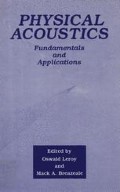Abstract
The scattering of a plane acoustic wave from immersed periodic structures has raised up a great deal of interest in underwater acoustics because they can be used as low frequency, wide bandwidth reflecting or absorbing baffles. These periodic structures are divided into two groups. The first one contains single periodic structures, such as single or double layered compliant tubes gratings, embedded or not in a viscoelastic layer. They are considered as reflecting baffles, in which the incident plane wave excites a resonance mode of the whole structure. The other group contains doubly periodic structures such as gradual tank lining or Alberich anechoic layers. They behave as a sound absorber, in which the incident plane acoustic wave excites a resonance mode of cylindrical or spherical inclusions, for instance. In order to explain their physical behavior and to help their design, several authors have built accurate mathematical models, which provided insertion loss values in nice agreement with measured values. Thus, Burke et al [1], Brigham et al [2], Duméry [3] and Audoly et al [4] have analyzed gratings of circular cylinders as well as of arbitrarily oriented, elliptically shaped compliant tubes, using a multiple scattering approach. From another point of view, Vovk et al [5], Radlinski et al [6] have used a waveguide approach to describe the behavior of tubes which have elongated rectangular section. Though powerful, all these methods require in every case a lot of specific algebraic developments, which restrict their use to a small number of given geometries. Moreover, they often rely upon simplifying assumptions for the structure or its displacement field, assumptions which rule out the resort to complex structures or materials. Thus, the use of the finite element method, with the help of ATILA code [7], to tackle these problems can strongly broaden the designer’s possibilities.
Associated to the CNRS, URA 253.
Access this chapter
Tax calculation will be finalised at checkout
Purchases are for personal use only
Preview
Unable to display preview. Download preview PDF.
References
E. Burke, V. Twersky, “On scattering of waves by an infinite grating of elliptic cylinders”, IEEE Trans. Antennas Propag., AP-14: 465, (1966).
G.A. Brigham, J.J. Libuha, and R.P. Radlinski, “Analysis of scattering from large planar gratings of compliant cylindrical shells”, J. Acoust. Soc. Am., 61: 48, (1977).
G. Duméry, “Sur la diffraction des ondes sonores par des grilles ou des réseaux d’obstacles”, Acustica, 18: 334, (1967).
C. Audoly, G. Duméry, “Etude d’écrans sous-marins constitués de tubes élastiques”, Acustica, 69: 263, (1989).
V. Vovk, V.T. Grinchenko and L.A. Kononuchenko, “Diffraction of a sound wave by a plane grating formed by hollow elastic bars”, Akust. Zh., 22: 201, (1976), [Sov. Phys. Acoust., 22: 113 (1976)].
R.P. Radlinsk, M.M. Simon, “Scattering by multiple gratings of compliant tubes”, J. Acoust. Soc. Am., 72: 607, (1982).
J.N. Decarpigny, J.C. Debus, P. Tierce, B. Tocquet, D. Boucher, “In-air analysis of piezoelectric Tonpilz transducers in a wide frequency band using a mixed finite element-plane wave method”, J. Acoust. Soc. Am., 78: 1499, (1985).
O.C. Zienkiewicz, “The finite element method”, 3rd Edition, Mc Graw Hill Ed., New York (1977).
A.C. Hennion, R. Bossut, J.N. Decarpigny, C. Audoly, “Analysis of the scattering of a plane acoustic wave by a periodic elastic structure using the finite element method: application to compliant tube gratings”, J. Acoust. Soc. Am., 87: 1861, (1990).
Author information
Authors and Affiliations
Editor information
Editors and Affiliations
Rights and permissions
Copyright information
© 1991 Plenum Press, New York
About this chapter
Cite this chapter
Hennion, AC., Bossut, R., Decarpigny, JN., Audoly, C. (1991). Application of the Finite Element Method to Analyze the Scattering of a Plane Acoustic Wave from Doubly Periodic Structures. In: Leroy, O., Breazeale, M.A. (eds) Physical Acoustics. Springer, Boston, MA. https://doi.org/10.1007/978-1-4615-9573-1_43
Download citation
DOI: https://doi.org/10.1007/978-1-4615-9573-1_43
Publisher Name: Springer, Boston, MA
Print ISBN: 978-1-4615-9575-5
Online ISBN: 978-1-4615-9573-1
eBook Packages: Springer Book Archive

